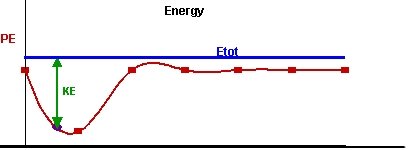Exploring Potential Energy Graphs
In this activity, students explore the graphical representation of
potential energy in one dimension. Students also investigate the roles of
kinetic energy (KE),
potential energy (PE
) and total energy (Etot) in
determining an object's motion. As seen below, the red curve represents
the object's potential energy, the blue line represents the object's total
energy and the object's current state is represented by the purple dot.
The potential energy can be manipulated by dragging the red rectangular
markers on the curve up and down. (The resulting potential energy curve is
produced by using a spline curve to follow the rectangular markers.) The
total energy can be manipulated by dragging the blue rectangular marker
blue horizontal line up and down. The starting condition of the object can
be altered by draging the purple circle to the left and right (along the PE
curve). Changing the position of the object changes the object's Kinetic
Energy (KE is shown in
green) since it is the difference between the object's potential energy at
its current location and the object's total energy.

Below
the Energy graph the a graph of the resulting force is displayed. At the
bottom of the window the object's position are motion are shown, with a
vector to indicate the force on the object. To the right of the energy,
force and motion graphs is a combined bar chart showing the object's
instantaneous potential, kinetic and total energy. A snapshot of the
complete applet window is shown below.

At
the bottom left of the window are the player controls. The play/pause
button starts the motion simulation of the object based upon the potential
energy graph and the position of the object. When the simulation is
restarted, the object's motion is always taken as being towards the right,
regardless of any previous runs of the simulation. The motion cannot be
started if the kinetic energy is negative (since this is unphysical) and
the objects properties cannot be manipulated while the simulation is
playing. The step button allows the operator to step through the
simulation. The reset button sets the potential energy, the total energy
and the object location all back to their defaults (as seen when this
applet first starts up).

